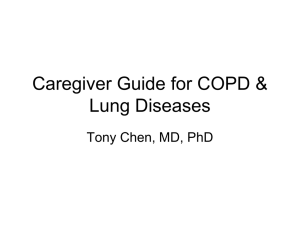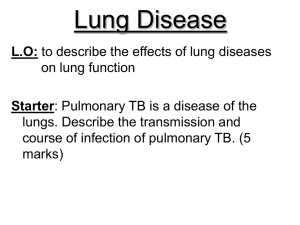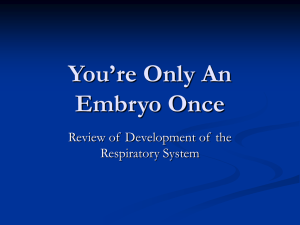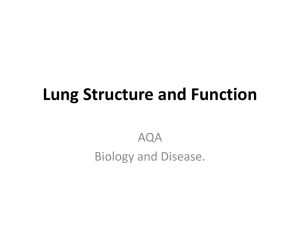Chapter 15 The Respiratory System
advertisement
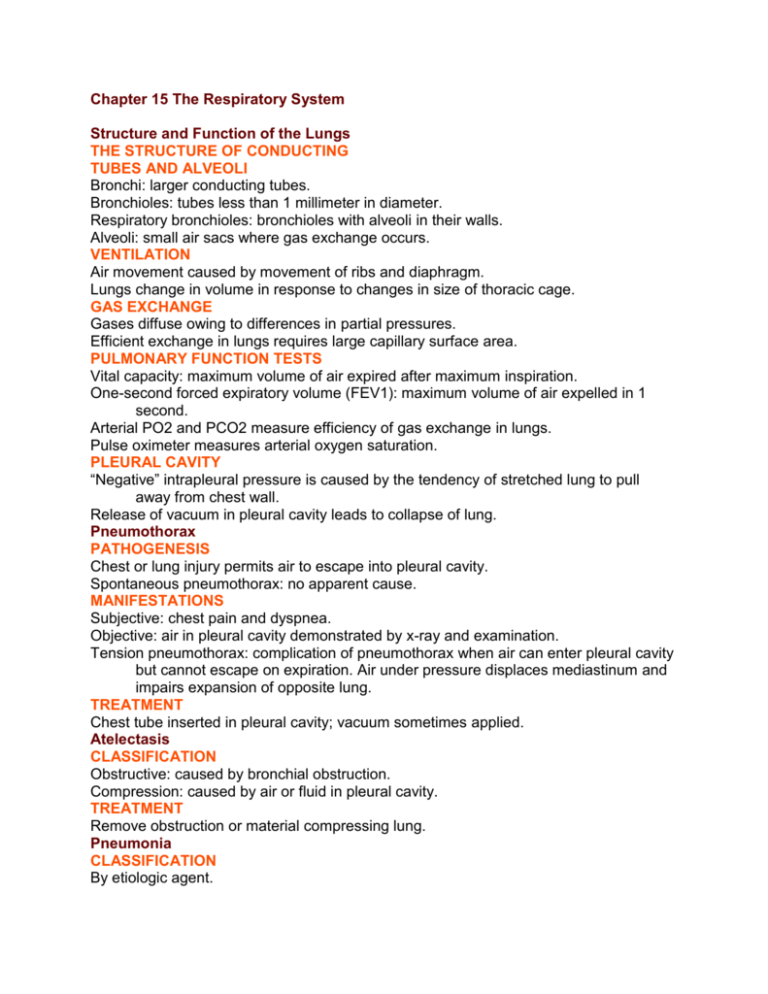
Chapter 15 The Respiratory System Structure and Function of the Lungs THE STRUCTURE OF CONDUCTING TUBES AND ALVEOLI Bronchi: larger conducting tubes. Bronchioles: tubes less than 1 millimeter in diameter. Respiratory bronchioles: bronchioles with alveoli in their walls. Alveoli: small air sacs where gas exchange occurs. VENTILATION Air movement caused by movement of ribs and diaphragm. Lungs change in volume in response to changes in size of thoracic cage. GAS EXCHANGE Gases diffuse owing to differences in partial pressures. Efficient exchange in lungs requires large capillary surface area. PULMONARY FUNCTION TESTS Vital capacity: maximum volume of air expired after maximum inspiration. One-second forced expiratory volume (FEV1): maximum volume of air expelled in 1 second. Arterial PO2 and PCO2 measure efficiency of gas exchange in lungs. Pulse oximeter measures arterial oxygen saturation. PLEURAL CAVITY “Negative” intrapleural pressure is caused by the tendency of stretched lung to pull away from chest wall. Release of vacuum in pleural cavity leads to collapse of lung. Pneumothorax PATHOGENESIS Chest or lung injury permits air to escape into pleural cavity. Spontaneous pneumothorax: no apparent cause. MANIFESTATIONS Subjective: chest pain and dyspnea. Objective: air in pleural cavity demonstrated by x-ray and examination. Tension pneumothorax: complication of pneumothorax when air can enter pleural cavity but cannot escape on expiration. Air under pressure displaces mediastinum and impairs expansion of opposite lung. TREATMENT Chest tube inserted in pleural cavity; vacuum sometimes applied. Atelectasis CLASSIFICATION Obstructive: caused by bronchial obstruction. Compression: caused by air or fluid in pleural cavity. TREATMENT Remove obstruction or material compressing lung. Pneumonia CLASSIFICATION By etiologic agent. By anatomic distribution of inflammation in lung. By predisposing factors. CLINICAL FEATURES Manifestations of systemic infection. Manifestations of lung inflammation: cough, chest pain. Severe Acute Respiratory Syndrome A serious highly communicable pulmonary infection. Caused by unique coronavirus. Initial nonspecific manifestations followed by acute respiratory distress syndrome. No antiviral therapy currently available. Pneumocystis Pneumonia Caused by protozoan parasite of low pathogenicity. Affects immunocompromised persons. Organisms injure alveoli, leading to exudation of proteinrich material into alveoli. Cysts demonstrated by special stains. Infection characterized by dyspnea, cough, pulmonary consolidation. Diagnosis established by lung biopsy. Treatment available, but infection has high mortality. Tuberculosis CHARACTERISTICS OF TUBERCULOSIS A granulomatous inflammation characterized by necrosis and giant cells. MANIFESTATIONS Depends on dosage and resistance. May heal by scarring or progress to cavitation. Miliary tuberculosis: dissemination of organisms by bloodstream. Extrapulmonary tuberculosis: hematogenous dissemination from lungs to distant site. DIAGNOSIS AND TREATMENT Skin test: indicates previous exposure to organism. Chest x-ray: indicates pulmonary infiltrate. Culture: identifies organism in sputum. Treatment by means of antibiotic and chemotherapeutic agents. Bronchitis and Bronchiectasis CLASSIFICATION Acute bronchitis: common and self-limited. Chronic bronchitis: secondary to chronic irritation. Bronchiectasis: walls weakened by inflammation and dilate. DIAGNOSIS AND TREATMENT Acute bronchitis: self-limited. Chronic bronchitis: cease irritation, as by cessation of smoking. Bronchiectasis: bronchogram demonstrates dilation. Diseased areas resected. Chronic Obstructive Lung Disease DEFINITION Combined emphysema and chronic bronchitis. DERANGEMENTS OF STRUCTURE AND FUNCTION Chronic inflammation of bronchioles leads to trapped air in lungs. Nonuniform ventilation of alveoli reduces efficiency of ventilation. Enlargement of air spaces and reduction of capillary bed reduces efficiency of gas exchange. Loss of lung elasticity requires active expiratory effort. PREVENTION AND TREATMENT OF EMPHYSEMA Refrain from smoking and inhalation of injurious agents. Treatment cannot restore damaged lung but can prevent further progression and may improve pulmonary function. EMPHYSEMA AS A RESULT OF ALPHA1 ANTITRYPSIN DEFICIENCY Antitrypsin prevents lung damage from lysosomal enzymes released from leukocytes in lung. Deficiency permits enzymes to damage lung tissue. Bronchial Asthma PATHOGENESIS Spasmodic contraction of bronchial smooth muscle narrows air passages. TREATMENT Drugs that relax bronchospasm or prevent release of mediators from mast cells. Many cases caused by allergy. Neonatal Respiratory Distress Syndrome PATHOGENESIS Inadequate surfactant impedes normal lung expansion and promotes collapse. Premature infants, infants born by cesarean section, and infants by diabetic mothers predisposed to syndrome. TREATMENT Administering of corticosteroids to mother may stimulate lung maturation in fetus. Intratracheal surfactant installation to treat affected infants. Adult Respiratory Distress Syndrome PATHOGENESIS Systemic disease with shock and impaired lung perfusion. Direct lung damage: trauma, gastric aspiration, inhalation of irritants or toxic gases. DERANGEMENT Damaged alveolar capillaries leak fluid and protein. Impaired surfactant production from damaged alveolar lining cells. Formation of hyaline membranes. TREATMENT Correct predisposing conditions. Administer oxygen under positive pressure. Pulmonary Fibrosis PATHOGENESIS Collagen diseases. Pneumoconioses: Silicosis. Asbestosis (also predisposes to lung carcinoma and pleural mesothelioma). Various other injurious substances inhaled in course of occupations. TREATMENT No specific treatment. Prevent occupational exposure. Lung Carcinoma PATHOGENESIS A smoking-related neoplasm. Mortality in women now exceeds breast carcinoma. Arises from mucosa of bronchi and bronchioles. CLASSIFICATION AND PROGNOSIS Several histologic types, which differ in their prognosis. Poor prognosis as a result of early spread to distant sites. TREATMENT Depends on histologic type. Generally by resection. Small cell carcinoma treated by chemotherapy and radiation.






